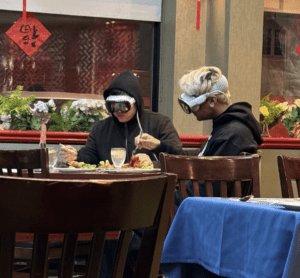Over half of employees claimed that they don’t regularly get respect from their leaders.
Bad customer service could cost businesses $3.7T annually.
Approximately half of U.S. adults report experiencing loneliness, with some of the highest rates among young adults.
As these facts have replayed in my mind, I’ve noticed a common denominator:
We aren’t seeing one another.
Whether this is at work from a manager or colleague.
Or when we need a problem solved by a customer service agent.
Or when we’re at home around our family and friends.
Very few of us feel seen.
And, the problem isn’t going away.
With the Apple Vision Pro now in the wild, images and videos like this have gone viral, with captions like this one on X, formerly known as Twitter: “not a phone in sight.”
 This brings us to where we are today, which Megan Garber summed up perfectly in her article in The Atlantic last year called “We’ve Lost the Plot,” where she pointed out:
This brings us to where we are today, which Megan Garber summed up perfectly in her article in The Atlantic last year called “We’ve Lost the Plot,” where she pointed out:
By the mid-20th century, the historian Warren Susman argued, a great shift was taking place. American values had traditionally emphasized a collection of qualities we might shorthand as “character”: honesty, diligence, an abiding sense of duty. The rise of mass media changed those terms, Susman wrote. In the media-savvy and consumption- oriented society that Americans were building, people came to value—and therefore demand—what Susman called “personality”: charm, likability, the talent to entertain. “The social role demanded of all in the new Culture of Personality was that of a performer,” Susman wrote. “Every American was to become a performing self.”
Said another way, we used to be seen and valued for our character.
Today, we are seen and valued for our performances – whether that’s generating a viral post on LinkedIn or a dance video on TikTok, posting the “right” photo to Instagram, or showing up to certain events.
At the same time, we seem to be drawn more and more to those who are performing versus those who are full of “character.”
This means all of us are performing more and more – and being seen less and less.
Ultimately leading to our collective loneliness.
So, what do we do?
The U.S. Surgeon General wrote an 82-page report on what to do, which I find a great place to start (check out the synopsis here).
But, as a first step, we may want to try one thing, especially at work.
In the first article I shared above (the one where 54% of employees said they didn’t feel respected by their bosses), there was one reason that bosses said they couldn’t respect their colleagues.
60% of bosses said they are overloaded and don’t have time to be nice.
They don’t have time to pause.
As a result, there is zero time to do something nice.
Because being nice isn’t just about being nice – it’s showing another person that we see them as a human who isn’t just known for their output.
And this is why I love the job I have.
Each and every day, I hear stories of venture accelerators, venture studios, and venture hubs in Morrow who get to walk alongside companies, slow them down, and see the founders for what they are: Humans who aren’t just performing.
Humans full of character who, just like each of us, need to be seen.
So, as we go from here, there are a lot of things we can do to perform. And, there are many ways we can reward those who are performing.
But maybe over the next few days, we watch how much we find ourselves performing.
And become more aware of how much we’re celebrating and watching those who are performing.
And, we take the time to find someone – maybe even someone who isn’t performing – to just be…
Nice.